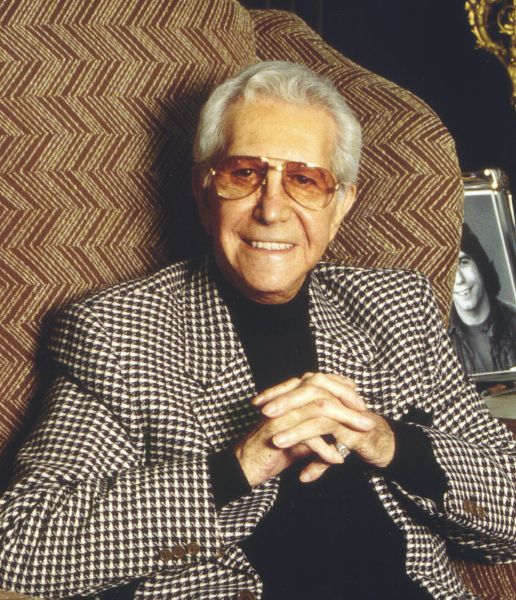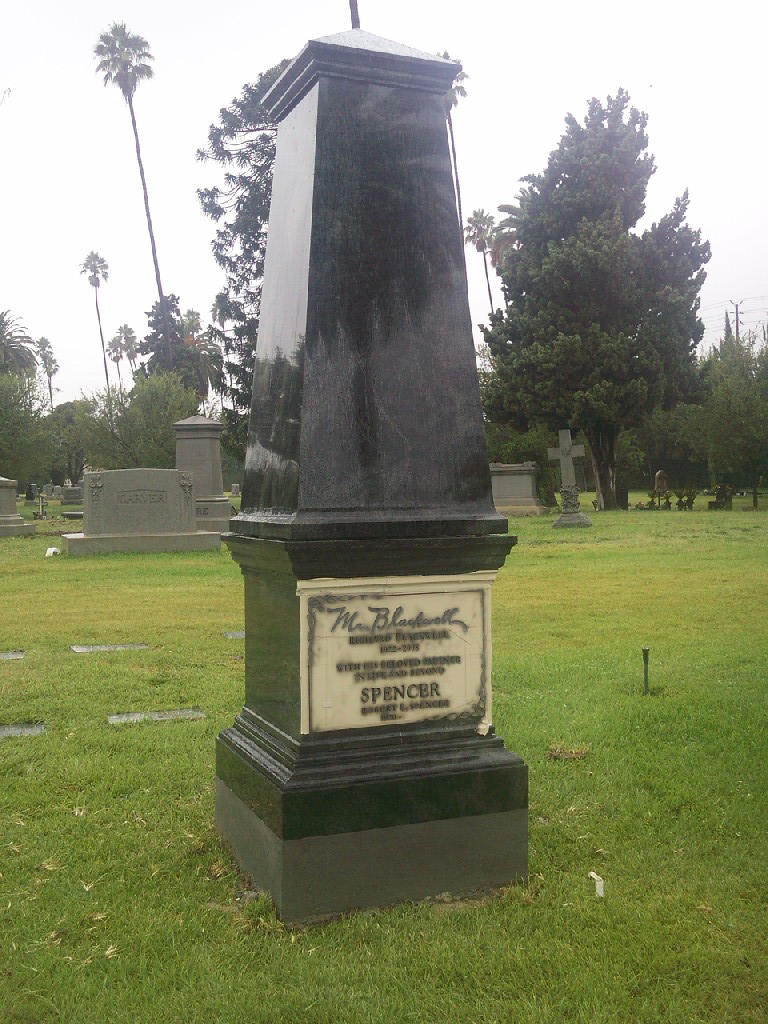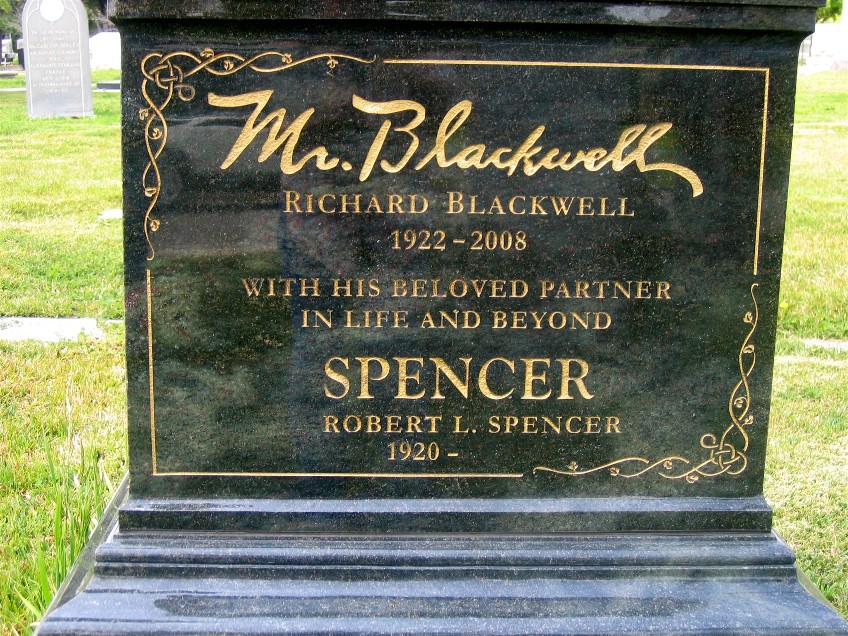Richard "Mr. Blackwell" Blackwell (Richard Sylvan Selzer)

Blackwell was born Richard Sylvan Selzer in the Bensonhurst section of Brooklyn to Henry Selzer, a working-class printer, and Eva Selzer, were the American-born children of Jewish immigrants from the Russian Empire. He had one older brother. He claimed he was severely beaten by a stepfather, often sleeping in the alley beneath a fire escape with a broken bottle for protection rather than face further abuse. He told Howard Stern that as a 7-year-old boy, he had once had to beg for a quarter on the street so he could buy something to eat. His mother was frequently absent or drunk, and men would take him to a nearby alley and abuse him. He was scared, hungry, and did whatever he could to stay alive. He only went as far as the third grade in school. When he was 11, he was raped by an adult at a boys’ camp.
Blackwell began acting in theaters in his teens, appearing in the original 1935 Broadway production of Sidney Kingsley’s Dead End. Relocating to the West Coast (where he studied with Judy Garland and Mickey Rooney) he adopted the professional name “Dick Ellis” and played small parts in the movies. Between acting parts, he worked as a messenger at Warner Bros. Studio in Burbank, California. Howard Hughes then signed him to RKO and changed his name to Richard Blackwell. He returned to Broadway in 1944 for Catherine Was Great, which starred Mae West, but left acting to become a Hollywood agent. He discovered his talent for fashion design while making stage costumes for his clients.
The name “Mr. Blackwell” came in the late-1950s when he launched his clothing line. As with Valentino, Versace and later Richard Tyler, he and his line became synonymous. He was an important designer and during the 1960s he became the first in history to present his line on a television broadcast, and was the first to make his line available for plus-size women. His designer dresses sold for between $800 to $1,000 and were very successful. During the nearly two decade existence of the “House of Blackwell”, he was designer to Yvonne DeCarlo, Jayne Mansfield, Dorothy Lamour, Jane Russell and California first lady Nancy Reagan. At the height of his prominence, he openly declared his disdain for Women’s Wear Daily and its publisher, John Fairchild. During the 1980s, the emerging drift toward casual wear brought an end to The House of Blackwell.
In his beginning years as a designer he was asked to do a one-time article for American Weekly magazine of the “10 Best and Worst Dressed” people and developed the franchise from it. Although best known for his “Worst Dressed“ list, he maintained a successful career as a fashion journalist. He was syndicated in The Globe tabloid and wrote features in newspapers and lifestyle magazines. His “Fabulous Fashion Independents” often featured celebrities whom in prior years have been listed in his Ten Worst Dressed.
The first “Ten Worst Dressed Women” list premiered in 1960, to moderate media success, but as the House of Blackwell became more successful, the list took off. By its third year every television and radio network and virtually all news services worldwide began to cover it. Forty-seven years after first release, Blackwell annually spent a week after its publication on telephone interviews to fashion magazines, radio programs and news networks. The list is a conglomeration of techniques from first letter alliteration: Martha Stewart – “dull, dowdy and devastatingly dreary” and consonant: “fabulous fashion independents”, to free verse: Cher – “A million beads/And one overexposed derriere”, and pun: Queen Elizabeth, “Was she the palace Christmas tree, or just a royal clown?” About Wynona Judd – “She looks like Hulk Hogan in sequins.” Often, he simply quipped: Martha Stewart – “Dresses like the centerfold for Farmers’ Almanac”, and other times combines forms: Dixie Chicks – “They look like a trio of truck stop fashion tragedies/ trapped in a typhoon”. The list’s popularity has waned in some segments of contemporary culture, many feeling that it is mean-spirited. However, Blackwell has displayed personal missives from many celebrities including Dolly Parton, Mariah Carey and country singer Tanya Tucker expressing their thanks for being selected. Other former list alumni like “Hollywood Beat” editor, Marci Weiner – “Why does Marci Weiner always dress like she’s auditioning for a Fellini movie?” – who was initially angered by her inclusion, now considers it an honor. Still, despite its decline in universal acceptance, it was nonetheless published each year.
The list spawned a parade of imitators from TMZ’s In The Zone: Mr. Blackwell vs. TMZ to the UK’s The Sun newspaper’s Sun Women Online: Celebrity Style Watch and the less known such as “The Catwalk Queen”. Not all are lists, but virtually all include jibes and jabs similar to those that Blackwell first used to capture media attention in the early 1960s. Harry Shearer’s Le Show radio program has featured “Blackwell on Blackwell.” Roger Stone, himself known for his taste in fashion, has taken up Blackwell’s tradition of best and worst dressed lists (albeit with a greater emphasis on the best dressed) since Blackwell’s death.
Mr. Blackwell was a pioneer in television fashion and had been a fixture in the medium throughout his career as a designer and critic. Most recently, he appeared as himself on an episode of the ABC daytime soap, Port Charles. He hosted a daily program on Los Angeles’ talk radio powerhouse KABC from 1972–74, moving to KIEV 1975–1981. In 1968 he starred in his own KCOP two hour color television special, Mr. Blackwell Presents, with Anna Maria Alberghetti, Nick Adams and Rose Marie. It was the first telecast in history in which a designer presented his line on television. He continued to be recognized as preeminent during his years in the field.
He often participated in audience critique segments on daytime talk and variety shows. He appeared on The Mike Douglas Show on numerous occasions, and on The Tonight Show Starring Johnny Carson, as a guest on the first broadcast after Carson moved the show from New York to Burbank. The May 2, 1972 episode also featured Rob Reiner, George Carlin and Johnny Mathis. He appeared on a total of four additional Tonight Shows between August 1970 and January 1973 and is included in the series Best Of The Tonight Show DVD sets.
Blackwell lived in the Hancock Park enclave of Los Angeles with his partner of 60 years, Robert Spencer. In 1964, they rented their home to The Beatles for the English band’s first visit to the city. It was leaked to the media, however, and the group made other arrangements. He was also an artist known for his avant-garde and he published several editions of his work, including his “Mother America” series.
In 2001, Blackwell was diagnosed with Bell’s palsy which causes limited to severe paralysis of facial muscles and can affect eyesight as well. If treated in time, it is completely curable; however, if not treated it can have life lasting effects. Blackwell was unable to unveil the 2000 list at a live news conference for the first time in its 40-year history and remained out of the public eye for six months. He came back for the 2001 “Worst Dressed” and returned to a full, normal social life. Blackwell died in Los Angeles on October 19, 2008 of complications from an intestinal infection.
Born
- August, 29, 1922
- USA
- Brooklyn, New York
Died
- October, 19, 2008
- USA
- Los Angeles, California
Cause of Death
- Complications from an intestinal infection
Cemetery
- Hollywood Forever Cemetery
- Hollywood, Los Angeles County, California
- USA




